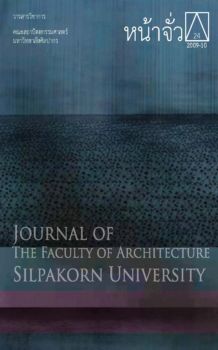การปรับใช้โครงข่ายประสาทเทียมเพื่อการออกแบบรูปด้านหน้าของตึกแถวในเชียงใหม่
Keywords:
Neural Network, Façade Design, Shophouse, Chiang Mai local lawAbstract
This study is an experiment of Neural Network in terms of categorizing. There has been a challenging study revealing the argument of Lanna Thai architectural style. This study continues in naming the components of shophouses. The analysis technique uses EasyNN, the software of Neural Network, which aims to conduct an experimental study. Forty-fi ve photos of shophouses are used. The result shows that EasyNN can categorize.
Applying Neural Network for Façade Design of the Shophouses in Chiang Mai, Thailand
Karuna Raksawin
Doctoral Student, Urban Planning and Design, Department of Urban Engineering, Faculty of Engineering, Osaka City University, Japan.
Assistant Professor, Faculty of Architecture, Chiang Mai University, Thailand.
Koichi Kana, Ph.D.
Associate Professor, Department of Urban Engineering, Faculty of Engineering, Osaka City University.
จากการบังคับใช้เทศบัญญัติเทศบาลนครเชียงใหม่เพื่อส่งเสริมลักษณะสถาปัตยกรรมล้านนาไทยได้เกิดข้อวิพากษ์ถึงลักษณะสถาปัตยกรรมล้านนาไทยของตึกแถวในเชียงใหม่ว่าควรเป็นอย่างไร การศึกษานี้จึงทดลองใช้โปรแกรม EasyNN ซึ่งเป็นโปรแกรมที่พัฒนาแนวคิดมาจากโครงข่ายประสาทเทียม หรือ Artifi cial Neural Network เพื่อช่วยแยกแยะตึกแถวแบบต่างๆ โดยการกำหนดชื่อลักษณะและส่วนประกอบซึ่งนำมาจากการบังคับใช้ของเทศบัญญัติเทศบาลนครเชียงใหม่เป็นตัวแทนของตัวแปรอิสระ และใช้ภาพถ่ายรูปด้านหน้าตึกแถวในเชียงใหม่จำนวน 45 ภาพ เป็นตัวแทนของตัวแปรตาม ผลการทดลองยืนยันได้ว่า โปรแกรม EasyNN สามารถแยกแยะรูปแบบของตึกแถวในเชียงใหม่ได้





